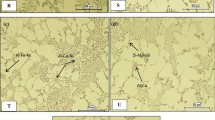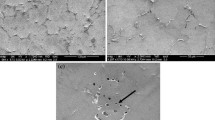Abstract
The present study was performed on the 354 (Al–9wt%Si–1.8wt%Cu–0.5wt%Mg)-based alloy to which measured amounts of Zr, Ni, Mn and Sc were added. Tensile test bars were prepared from the different 354 alloys using an ASTM B-108 permanent mold. The test bars were solution heat-treated using a one-step or a multi-step solution heat treatment, followed by quenching in warm water, and then artificial aging employing different aging treatments. Tensile bars were thereafter tested at 25 and 250 °C. Analysis of the tensile data was carried out using quality charts and color contour maps. The results show that at room temperature, Alloy R (354 + 0.25%Zr) showed the best quality index values after T6 treatment, i.e., 411 and 418.64 MPa without, and with 200-h stabilization at 250 °C, respectively. Alloy U (354 + 0.25%Zr + 0.75%Mn) displayed a Q-value of 397.84 MPa after T6 treatment (with no stabilization) and 404.62 MPa following T6 treatment and 200-h stabilization at 250 °C before testing. At 250 °C testing temperature and after 200-h stabilization at 250 °C, the strength of all alloys exhibited a decrease in strength with an increase in ductility being related to the softening, which occurred due to the onset of overaging.











Similar content being viewed by others

References
M. Zeren, Effect of copper and silicon content on mechanical properties in Al–Cu–Si–Mg alloys. J. Mater. Process. Technol. 169(2), 292–298 (2005)
E. Sjölander, S. Seifeddine, The heat treatment of Al–Si–Cu–Mg casting alloys. J. Mater. Process. Technol. 210(10), 1249–1259 (2010)
C.H. Caceres, I.L. Svensson, J.A. Taylor, Strength-ductility behaviour of Al–Si–Cu–Mg casting alloys in T6 temper. Int. J. Cast Met. Res. 15(5), 531–543 (2003)
F. Stadler, H. Antrekowitsch, W. Fragner, H. Kaufmann, P.J. Uggowitzer, The effect of Ni on the high-temperature strength of Al–Si cast alloys, in Materials Science Forum, vol. 690 (Trans Tech Publications, Aedermannsdorf, 2011), pp. 274–277
A.M.A. Mohamed, F.H. Samuel, A.M. Samuel, H.W. Doty, Influence of additives on the impact toughness of Al–10.8% Si near-eutectic cast alloys. Mater. Des. 30(10), 4218–4229 (2009)
M.S. Kaiser, A.S.W. Kurny, Effect of scandium on the grain refining and ageing behaviour of cast Al–Si–Mg alloy. Iran. J. Mater. Sci. Eng. 8(4), 1–8 (2011)
M.N. Ervina Efzan, H.J. Kong, C.K. Kok, Review: effect of alloying element on Al–Si alloys. Adv. Mater. Res. 845, 355–359 (2014)
F. Stadler, H. Antrekowitsch, W. Fragner, H. Kaufmann, P.J. Uggowitzer, Effect of main alloying elements on strength of Al–Si foundry alloys at elevated temperatures. Int. J. Cast Met. Res. 25, 215–224 (2012)
C.G. Garay-Reyes, C.D. Gómez-Esparza, I. Estrada-Guel, J. Aguilar-Santillan, M.C. Maldonado-Orozco, R. Martínez-Sánchez, Effect of Nickel addition and solution treatment time on microstructure and hardness of Al–Si–Cu aged alloys. Mater. Charact. 120, 168–174 (2016)
M. Tash, F.H. Samuel, F. Mucciardi, H.W. Doty, Effect of metallurgical parameters on the hardness and microstructural characterization of as-cast and heat-treated 356 and 319 aluminum alloys. Mater. Sci. Eng., A 443(1–2), 185–201 (2007)
O. Elsebaie, A.M.A. Mohamed, A.M. Samuel, F.H. Samuel, A.M.A. Al-Ahmari, The role of alloying additives and aging treatment on impact behavior of 319 cast alloy. Mater. Des. 32(6), 3205–3220 (2011)
L. Alyaldin, Effects of alloying elements on room and high temperature tensile properties of Al–Si–Cu–Mg base alloys. M.Sc. thesis, UQAC, 2017
L. Jonathan, NASA 398 Material Properties Data Sheet (NASA-Marshall Space Flight Center, Huntsville, 2001)
M. Drouzy, S. Jacob, M. Richard, Interpretation of tensile results by means of quality index and probable yield strength-application to Al–Si7 Mg foundry alloys-France. Int. Cast Met. J. 5(2), 43–50 (1980)
G.H. Garza-Elizondo, A.M. Samuel, S. Valtierra, F.H. Samuel, Effect of transition metals on the tensile properties of 354 alloy: role of precipitation hardening. Int. J. Metalcast. 11(3), 413–427 (2017)
F.H. Samuel, A.M. Samuel, H.W. Doty, Factors controlling the type and morphology of Cu-containing phases in 319 Al alloys. AFS Trans. 104, 893–901 (1996)
H.R. Ammar, Influence of metallurgical parameters on the mechanical properties and quality indices of Al–Si–Cu–Mg and Al–Si–Mg casting alloys. Thesis, University of Quebec at Chicoutimi, 2010
Dong-Woo Suh, Sang-Yong Lee, Kyong-Hwan Lee, Su-Keun Lim, Oh Kyu Hwan, Microstructural evolution of Al–Zn–Mg–Cu–(Sc) alloy during hot extrusion and heat treatments. J. Mater. Process. Technol. 155–156, 1330–1336 (2004)
V.G. Davydov, T.D. Rostova, V.V. Zakharov, Y.A. Filatov, V.I. Yelagin, Scientific principles of making an alloying addition of scandium to aluminium alloys. Mater. Sci. Eng., A 280(1), 30–36 (2000)
A.J. Tolley, V. Radmilovic, U. Dahmen, On the effect of Zr on precipitate evolution in Al–Sc–Zr alloys, in Congress CONAMET/SAM 2004 Proceedings, La Serena, Chile, 2004
Acknowledgements
The authors would like to thank Amal Samuel for enhancing the quality of the art work used in the present study.
Author information
Authors and Affiliations
Corresponding author
Appendix
Appendix
The quality of aluminum alloy castings may be defined using the quality index Q which provides a correlation with the mechanical properties. Drouzy et al. first proposed the concept of quality index in 1980 in relation to their investigations of the tensile properties of Al-7%Si–Mg alloys containing different levels of Mg, and defined Q in terms of the following equation:
In Eqn. 1, UTS stands for the ultimate tensile strength in MPa, Af stands for the elongation to fracture in pct, and d is an empirical coefficient (150 MPa) chosen such as to make Q practically independent of the aging condition. The probable yield strength Rp of an Al–Si–Mg alloy may be assessed by the equation:
where a, b and c are alloy-dependent empirically determined coefficients. From the above equations, a quality chart can be generated. In a typical quality chart, which is a diagram of the ultimate tensile strength versus the logarithm of the elongation to fracture, Eqns. 1 and 2 represent sets of parallel lines termed iso-Q and iso-YS lines, respectively; they fit the experimentally obtained Q and Rp values resulting from variations in chemical composition, solidification conditions and heat treatment of Al–Si–Mg aluminum alloys with a good approximation. Such charts are therefore very useful in selecting alloys for specific applications and understanding how the properties may be manipulated to achieve the desired specifications.
A model developed by Câceres shows that the iso-Q lines represent contours of constant relative ductility, the latter thus providing a simple physical rationale for the Q parameter. The Câceres model assumes that the material can be described with a constitutive equation of the form:
where σ is the true flow stress, K is the strength coefficient, n is the strain-hardening exponent, and \(\epsilon\) is the true plastic strain. From the true stress–strain curves, the following relationships can be established
where s is the engineering plastic strain, and P is the engineering stress. Equation 4 was used to generate the flow curves, setting K = 430–500 MPa (for 354 alloy) and varying n between 0.08 and 0.2 to represent different aging conditions.
The iso-quality lines can also be generated using Eqn. 4 by introducing the relative ductility parameter, q, defined as the ratio between the strain-hardening exponent of the material and the elongation to fracture, Sf,
where q = 1 when the samples reach necking (i.e., the most ductile samples), while q < 1 identifies progressively less ductile samples. Thus, q = 0.5, 0.2, 0.1 identifies samples which fail at 50, 20 or 10% of their necking onset strain, respectively. Solving Eqn. 5 for n and substituting in Eqn. 4 gives
Equation 6 was used to generate the set of constant relative ductility contour lines,or iso-q, each identified by a q-value. It will be observed that the iso-q lines are nearly parallel to the empirically determined iso-Q lines. The correlation between iso-q lines and iso-Q lines provides a straightforward physical meaning for the quality index in terms of the relative ductility parameter; a constant Q-value implies constant relative ductility, q. The maximum quality corresponds to samples which reach necking and thus display the maximum relative ductility. By combining the above equations, the quality index becomes a function of the parameters of the flow curve:
An approximation of Eqn. 7 could be Eqn. 8 which makes it possible to calculate the quality index from the tensile test results based solely on the knowledge of the value of K.
Rights and permissions
About this article
Cite this article
Alyaldin, L., Abdelaziz, M.H., Samuel, A.M. et al. Effects of Alloying Elements and Testing Temperature on the Q-Index of Al–Si Based Alloys. Inter Metalcast 12, 839–852 (2018). https://doi.org/10.1007/s40962-018-0215-6
Published:
Issue Date:
DOI: https://doi.org/10.1007/s40962-018-0215-6



